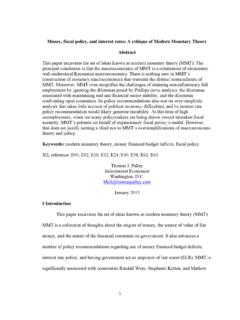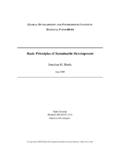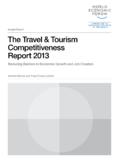Transcription of From Keynesianism to Neoliberalism: Shifting Paradigms in ...
1 From Keynesianism to neoliberalism : Shifting Paradigms in Economics By Thomas I. Palley April 2004 Thomas I. Palley is the chief economist at the Security Review commission . This essay will appear as a chapter in a book by Deborah Johnston and Alfredo Saad-Filho, eds., neoliberalism --A Critical Reader (Pluto Press, 2004). The intellectual foundations of neoliberalism (T)he ideas of economists and political philosophers, both when they are right and when they are wrong, are more powerful than is commonly understood. Indeed, the world is ruled by little else. Practical men, who believe themselves to be quite exempt from any intellectual influences, are usually the slave of some defunct economist. John Maynard Keynes, The General Theory of Employment, Interest and Money (1936), For the last 25 years, economic policy and the public s thinking have been dominated by a conservative economic philosophy known as neoliberalism .
2 The reference to liberalism reflects an intellectual lineage that connects with 19th century economic liberalism associated with Manchester, England. The Manchester system was predicated upon laissez-faire economics and was closely associated with free trade and the repeal of England s Corn Law, which restricted importation of wheat. Contemporary neoliberalism is principally associated with the Chicago School of Economics, which emphasizes the efficiency of market competition, the role of individuals in determining economic outcomes, and distortions associated with government intervention and regulation of Two critical tenets of neoliberalism are its theory of income distribution and its theory of aggregate employment determination. With regard to income distribution, neoliberalism asserts that factors of production--labor and capital--get paid what they are worth.
3 This is accomplished through the supply and demand process, whereby payment depends on a factor s relative scarcity (supply) and its productivity, which affects demand. With regard to aggregate employment determination, neoliberalism asserts that free markets will not let valuable factors of production--including labor--go to waste. Instead, prices will adjust to ensure that demand is forthcoming and that all factors are employed. This assertion is at the foundation of Chicago School monetarism, which claims that economies automatically self-adjust to full employment and that the use of monetary and fiscal policy to permanently raise employment merely generates 1 Key figures in the Chicago School are Milton Friedman, George Stigler, Ronald Coase and Gary Becker--all of whom have been awarded the Nobel Prize in economics.
4 2 Monetary policy is conducted by central banks, who manage interest rates to affect the level of economic activity. Fiscal policy refers to government management of spending and taxation to affect economic activity. 1 These two theories have been extraordinarily influential, and they contrast with the thinking that held sway in the period between 1945 and 1980. During this earlier era, the dominant theory of employment determination was Keynesianism , which maintains that the level of economic activity is determined by the level of aggregate Additionally, Keynesians maintain that capitalist economies are subject to periodic weakness in the aggregate demand generation process, resulting in unemployment. Occasionally, this weakness can be severe and produce economic depressions--as exemplified by the Great Depression. In such a world, monetary and fiscal policy can stabilize the demand generation process.
5 With regard to income distribution, Keynesians have always been divided, and this created a fatal breach that facilitated the triumph of neoliberalism . American Keynesians (known as neo-Keynesians) tend to accept the neoliberal paid what you are worth theory of income distribution, while European Keynesians (widely associated with Cambridge, , and known as post-Keynesians) reject it. Instead, post-Keynesians argue that income distribution depends significantly on institutional factors. Thus, not only do a factor s relative scarcity and productivity matter, but so too does its bargaining power, which is impacted by institutional arrangements. This explains the significance of trade unions, laws governing minimum wages, employee rights at work, and systems of social protection such as unemployment insurance. Finally, public understandings of the economy also matter, since a public that views the economy through a bargaining power lens will have greater political sympathies for trade unions and institutions of social protection.
6 The great reversal: the decline of Keynesianism and the rise of neoliberalism For the 25 years after World War II (1945-1970), Keynesianism constituted the dominant paradigm for understanding the determination of economic activity. This was the era in which modern tools of monetary policy (control of interest rates) and fiscal policy (control of government spending and taxes) were developed. It was also a period in which union coverage rose to historical highs and New Deal style institutions of social protection and regulation were expanded. However, in the mid-1970s the Keynesian impulse went into reverse, to be replaced by neoliberalism . This reversal piggybacked on the social and economic dislocations associated with the Vietnam War era and the OPEC oil price shocks, which dominated the 1970s. However, these dislocations only provided an entry point.
7 The ultimate spark of neoliberal dynamism is to be found in the intellectual divisions of Keynesianism and its failure to develop public understandings of the economy that could compete with the neoliberal rhetoric of free markets. Throughout the period of Keynesian dominance, there remained deep conservative opposition within the United States, providing a base from which to launch a neoliberal assault. This opposition had been present during the New Deal period, as manifested in conservative resistance to the creation of the Social Security retirement 3 Aggregate demand is the total level of demand for goods and services in an economy. Keynesians believe that firms produce on the basis of their expectations of the level of aggregate demand and that the level of aggregate demand thus determines the overall level of economic activity.
8 2income system. And the antagonism continued after World War II, as illustrated by the conservative-sponsored Taft-Hartley Act (1947), which sowed the seeds that eventually eviscerated the rights of American workers to form unions by undermining union power and the ability to organize. The appeal of neoliberalism was also enhanced by economic and cultural factors. At the economic level, the success of New Deal Keynesianism may have contributed to its own undoing. Rising prosperity, built upon Keynesian policies and the postwar social contract between business and labor, may have engendered beliefs that the core economic problems of income distribution and mass unemployment had finally been solved. As a result, citizens may gradually have come to view as dispensable the very policies and institutions--such as unions--that had brought about their now-presupposed prosperity.
9 At the cultural level, America has always celebrated radical individualism, as epitomized in the frontiersman image. This radical individualism was further promoted by the ideological conflict embedded in the Cold War, which fostered antipathy to notions of collective economic action and denial of the limitations of market capitalism. In particular, collective economic action was tarred by identification with the communist approach to economic management. The Cold War, therefore, provided fertile ground for popularizing an economic rhetoric that spoke of natural free markets independent of governments and in which government regulation reduces Yet, as important as political and cultural factors were in explaining the appeal of neoliberalism , Keynesianism also suffered from internal intellectual divisions that made for weakness. One source of division was the theory of income distribution.
10 Keynes was a believer in the marginal product theory of income distribution, whereby workers get paid what they are worth to the company. This gives little justification for trade unions and other forms of labor market intervention, all of which can be painted as market distortions rather than corrections of market failure associated with unequal bargaining power. In effect, whereas Keynesians contributed greatly to understanding the factors of aggregate demand and its role in determining employment outcomes, they developed no matching analysis of production conditions and their interactions with and impacts on aggregate A second Keynesian weakness was the belief that downward price and (especially) nominal wage rigidity were responsible for unemployment. This position emerged in the 1940s, a decade after the publication of Keynes 1936 book, The General Theory of Employment, Interest and Money.





